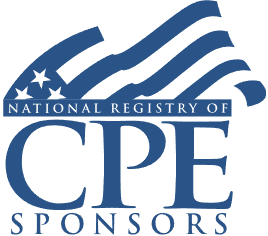SECURE Act: Addressing Significant Changes to Retirement Planning
RMDs, Qualified Charitable Distributions, Elimination of Stretch IRAs, Part-Time Employees, and Multi-Employer Plans

Welcome! Strafford is now BARBRI! The expert courses you know from the trusted global leader in legal education.
Course Details
- smart_display Format
On-Demand
- signal_cellular_alt Difficulty Level
Intermediate
- work Practice Area
Tax Preparer
- event Date
Tuesday, April 28, 2020
- schedule Time
1:00 p.m. ET./10:00 a.m. PT
- timer Program Length
110 minutes
-
BARBRI is a NASBA CPE sponsor and this 110-minute webinar is accredited for 2.0 CPE credits.
-
BARBRI is an IRS-approved continuing education provider offering certified courses for Enrolled Agents (EA) and Tax Return Preparers (RTRP).
This course will explain the significant changes made by the Setting Every Community Up for Retirement Enhancement Act (SECURE Act) to retirement and tax planning. The panel will discuss the changes made by the SECURE Act, including developing new planning strategies after its passage.
Faculty

Ms. Archibald has more than 30 years of experience in providing estate, gift and fiduciary compliance, and tax planning services with a special emphasis in wealth transfer and estate planning. She is the co-Principal in Charge of the firm’s Wealth Transition Services. Ms. Archibald assists clients with the development of their estate plan by reviewing their goals and providing recommendations for plan structure to reduce potential estate tax liabilities, and also helps clients develop lifetime gifting strategies such as the use of GRATs, charitable trusts, family partnerships and sales to grantor trusts. She provides transition planning with clarity and offers specific solutions to estate planning questions.

Mr. Schwarz has over 37 years of experience specializing in legislative affairs, including development and implementation of tax legislation at the national level. He spends his time at the capitol meeting with legislators, listening in on updates impacting tax processes and procedures and providing timely updates and education on issues and opportunities impacting clients. Mr. Schwarz is a sought-after speaker for many AICPA, TEI and FEI conferences.
Description
The SECURE Act's end of year passage and the effective date of 2020 has charged tax professionals not only with grasping its many revisions but also with developing new retirement strategies in light of its far-reaching effects. SECURE Act changes include an increase in the required minimum distribution age from 70-and-one-half to 72, elimination of stretch IRAs (payouts must now take place within 10 years of the date of death), and the extension of elective deferrals to certain part-time employees.
Less talked about are the allowance of consolidated Form 5500 form filing, penalty-free distributions from qualified plans and IRAs for births and adoptions, and the new calculations for qualified charitable distributions. Tax advisers and preparers need to be aware of the multitude of changes made by this act.
Experts are already touting methods to circumvent the effects of the SECURE Act. These include Roth conversions, renaming beneficiaries, and using IRA trusts and life insurance in estate plans. Knowing when and how to implement these strategies is key to providing the most significant potential tax savings and asset preservation for clients, estates, and businesses.
Listen as our panel of experts reviews the multitude of changes included in the SECURE Act, including the changes to discrimination testing, the elimination of stretch IRAs, including part-time employees in retirement plans, and the planning opportunities afforded by the passage of the SECURE Act.
Outline
- The SECURE Act: an overview
- Individual changes
- Required minimum distributions
- Roth conversions
- Other changes
- Estate plans
- Stretch IRAs
- Beneficiary designations
- IRA trusts
- Other
- Planning opportunities
- Qualified charitable contributions
- Charitable trusts
- Life insurance
- Other strategies
- Business changes
- Discrimination testing
- Elective deferrals by part-time employees
- Multi-employer plans
- Other changes
Benefits
The panel will review these and other key issues:
- How to compute qualified charitable distributions from IRAs
- Which part-time employees qualify for elective deferrals
- IRA planning strategies after the elimination of the STRETCH IRA
- When should a taxpayer consider a Roth conversion?
- How does the SECURE Act impact pooled employer plans?
NASBA Details
Learning Objectives
After completing this course, you will be able to:
- Determine retirement strategies impacted by the Act
- Decide when beneficiary designation changes may be beneficial
- Identify significant changes made by the passage of the SECURE Act
- Ascertain when conversion to a Roth may be a worthwhile strategy
- Field of Study: Taxes
- Level of Knowledge: Intermediate
- Advance Preparation: None
- Teaching Method: Seminar/Lecture
- Delivery Method: Group-Internet (via computer)
- Attendance Monitoring Method: Attendance is monitored electronically via a participant's PIN and through a series of attendance verification prompts displayed throughout the program
- Prerequisite: Three years+ business or public firm experience preparing complex tax forms and schedules, supervising other preparers or accountants. Specific knowledge and understanding of pass-through taxation, including taxation of partnerships, S corporations and sole proprietorships, qualified business income, net operating losses and loss limitations; familiarity with net operating loss carry-backs, carry-forwards and carried interests.

Strafford Publications, Inc. is registered with the National Association of State Boards of Accountancy (NASBA) as a sponsor of continuing professional education on the National Registry of CPE Sponsors. State boards of Accountancy have final authority on the acceptance of individual courses for CPE Credits. Complaints regarding registered sponsons may be submitted to NASBA through its website: www.nasbaregistry.org.

Strafford is an IRS-approved continuing education provider offering certified courses for Enrolled Agents (EA) and Tax Return Preparers (RTRP).
Unlimited access to premium CLE courses:
- Annual access
- Available live and on-demand
- Best for attorneys and legal professionals
Unlimited access to premium CPE courses.:
- Annual access
- Available live and on-demand
- Best for CPAs and tax professionals
Unlimited access to premium CLE, CPE, Professional Skills and Practice-Ready courses.:
- Annual access
- Available live and on-demand
- Best for legal, accounting, and tax professionals
Unlimited access to Professional Skills and Practice-Ready courses:
- Annual access
- Available on-demand
- Best for new attorneys
Related Courses

Redemptions of Partnership Interests: Sections 736(b) vs. 736(a)
Friday, October 31, 2025
1:00 p.m. ET./10:00 a.m. PT

Multistate Tax Treatment of Multi-Tier Partnerships: Ingesting PTET in a Multi-Tier Entity
Friday, September 19, 2025
1:00 p.m. ET./10:00 a.m. PT

IRA Distributions and RMDs: Minimizing Taxes and Meeting SECURE 2.0 Requirements
Available On-Demand

Avoiding Gift and Estate Audit Triggers: Anticipating Audit Issues, IDRs, and Appeals
Tuesday, September 9, 2025
1:00 p.m. ET./10:00 a.m. PT
Recommended Resources
How CPE Can Bridge the Gap Between What You Know and What You Need to Know
- Career Advancement